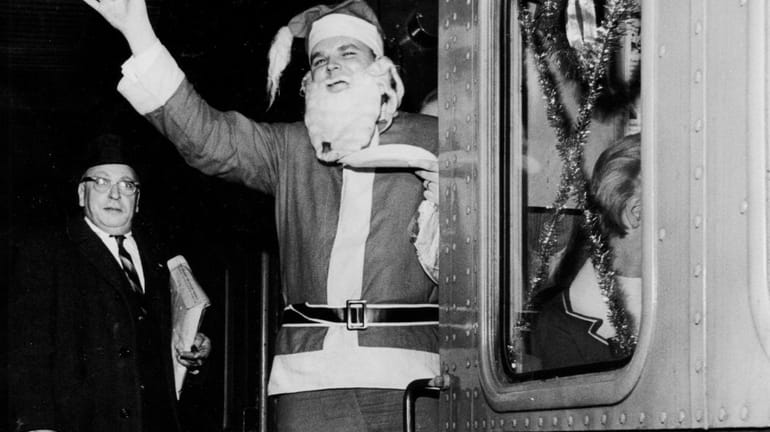David Morrison pens book into Jamaica station's past

Dave Morrison handles some of his miniature trains in the cellar of his Plainview home. (Dec. 29, 2011) Credit: Jeremy Bales
Have you heard the one about the LIRR rider at the pearly gates? There, St. Peter asks him whether he thinks he deserves to go to heaven or hell. "I don't care where you send me," the weary commuter replies, "as long as I don't have to change at Jamaica."
That "change at Jamaica" phrase has become part of Long Island language and lore: Familiarity with Jamaica station in Queens -- and what or what not to do when you arrive via train -- ranks up there with correctly pronouncing Hauppauge in determining your Nassau-Suffolk credentials.
There's also a novel, a rock band, a song and at least one blog called "Change at Jamaica" -- the latter adds ominously in its subhead that these are "three words nobody wants to hear."
David Morrison, a longtime Long Island Rail Road historian and a former branch manager, likes to tell that joke about the commuter. He worked for 25 years at the railroad, including a 14-year stint at Jamaica, so he knows full well its impact on generations of Long Island commuters.
"It's the hub of the railroad," said Morrison, 66, who lives in Plainview. "It's also the nerve center."
From the station's second-floor Transportation Movement Bureau, the LIRR's entire system is managed. Here, dispatchers can see all the trains in real time on screens and manage their movements and timetables. Also, since 10 of 11 branches converge at Jamaica, there are more switches here than at any other single location on the LIRR. All switching into and out of Jamaica is controlled from a computerized control room in the Jamaica Control Center.
The station is now also the subject of a photo-history authored by Morrison and published by Arcadia Press as part of its "Images of Rail" local history series. Morrison -- whose railroading passions extend to two model train layouts in his basement (O and G gauge), along with an extensive personal library of railroading books -- collected more than 200 archival images for the book from various sources, including LIRR archives, those of other local historians and his own collection, which includes a rare 1873 atlas of the Jamaica station area, as well as old timetables and other LIRR ephemera.
"Jamaica Station" ($21.99) tells the story of how a once-sleepy village in Queens became the site in 1913 of a massive LIRR complex that now serves nearly 250,000 commuters a day.
The station is also a link from the LIRR -- and Manhattan bus and subway lines -- to the Metropolitan Transportation Authority's AirTrain light-rail service to Kennedy Airport, not to mention the LIRR's headquarters, from which the entire rail system for Nassau-Suffolk is controlled.
Perhaps the most important thing about Jamaica station, though, is its critical relationship to the development of modern Long Island.
"The basis of suburbia was established through the commuters coming through Jamaica," said Nassau County historian Ed Smits. "It was the efficiency of operations that Jamaica enabled, which led to the tremendous increase in commuters from Nassau and even Suffolk by the end of the 1920s, and of course, later, after World War II."What motivated Morrison to write a book about it? "My passion in railroading has always been with stations," said Morrison, who has authored three other photo-history books, including one on Long Island's historic railroad stations. "I find it fascinating, the history of these structures, and the beauty."
Jamaica station was designed by one of the most prominent architects of the era, Kenneth M. Murchison, who also designed the Manhattan Beach and Long Beach LIRR stations, in addition to the Lackawanna Terminal in Hoboken, N.J., and many others. While Jamaica is more of a utilitarian structure, Murchison's most famous creation -- the Forest Hills tennis stadium, built 10 years after Jamaica station, in 1923 -- is a widely acknowledged aesthetic triumph.
While it is not as iconic as Penn Station or Grand Central Terminal, Morrison points out that in the mid-20th century Jamaica station buzzed with activity, commerce and the kind of facilities reminiscent of a romantic and bygone age in rail travel, including a barbershop, a shoeshine stand, a ticket island in the middle of the waiting room floor and lockers where people could store luggage while they traveled.
The history of rail service in Jamaica goes back long before the golden age of Dashing Dan, the cartoon symbol of Long Island's commuter rail service for many years: As Morrison shows in his book, the first train to pass on newly laid tracks in Jamaica was in 1836, at the very dawn of America's railroads (a rare drawing of that primitive steam engine is included in the book).
For much of the 19th century, there were actually two Jamaica stations: one run by the LIRR and the other by the long-defunct South Side Railroad. As passenger and freight rail service to and from Long Island grew, and the Pennsylvania Railroad consolidated its control over the LIRR, more lines began converging at Jamaica.
By the early 1900s, six tracks ran through the village at street level, creating a bottleneck for the railroad, and making it dangerous for pedestrians to get from one side of town to the other (by then, Jamaica itself had developed into a busy retail shopping area).
In 1910, everything changed: That was the year the Jamaica Improvement Project was launched. It was one of a wave of massive projects undertaken around the same time -- including Pennsylvania Station, Grand Central Terminal and the rail tunnels under the East River -- that would create the modern transportation infrastructure of New York and Long Island.
The improvement project was a three-year, $4-million undertaking that involved building a modern, new station one-third of a mile west of the old wooden one, and constructing eight elevated lines and five platforms, along with a five-story brick station and office building.
"The amazing thing," Morrison noted, "is that it was all done privately, with no public funding."
The first train to depart from the new Jamaica station (nobody changed trains, according to accounts) was the 4:47 a.m. to Speonk, a so-called "newspaper train" meant to deliver the latest editions of the New York newspapers to far-flung outposts of Long Island's East End.
The opening of the Jamaica station in March 1913 was heralded in The New York Times as the beginning of an "Era of Great Long Island Improvements." In a full-page story on the new station and its impact, the paper predicted accurately that the completion of the terminal would bring with it "a great influx of population to Long Island."
Still, much of the rail-riding population would grumble about Jamaica for years, because while the new station helped make Long Island more accessible, the lack of uniform equipment across the line meant that passengers had to leave their steam- and, later, diesel-powered trains to transfer to the electric trains that ran through the tunnels into Manhattan. Those transfers occurred at Jamaica.
Today, almost all the lines are electrified. In addition, the LIRR now has dual-power locomotives that can run on electric and diesel power. The result is that despite all the nostalgia, all the eponymous songs, blogs and bands, most LIRR commuters -- 81 percent -- no longer have any need to change at Jamaica.
But for old-time's sake, they can read about it, instead.
Jamaica station
Jamaica station is composed of an eight-track, eight-platform, open-air train terminal, the adjacent five-story LIRR headquarters building and ticket office, the seven-story Jamaica Control Center and the Port Authority AirTrain terminal. Other station tidbits:
- It opened in 1913.
Sources: MTA, Long Island Rail Road

